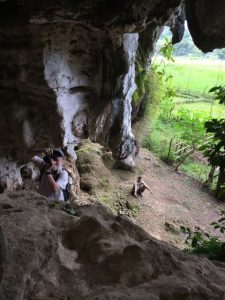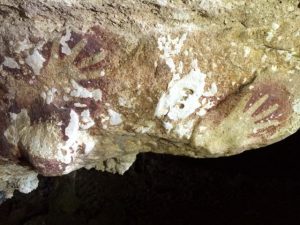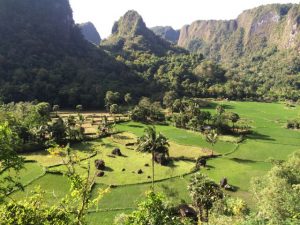
I struggle to keep my footing on a narrow ridge of earth snaking between flooded fields of rice. The stalks, almost ready to harvest, ripple in the breeze, giving the valley the appearance of a shimmering green sea. In the distance, steep limestone hills rise from the ground, perhaps 400 feet tall, the remains of an ancient coral reef. Rivers have eroded the landscape over millions of years, leaving behind a flat plain interrupted by these bizarre towers, called karsts, which are full of holes, channels and interconnecting caves carved by water seeping through the rock.
We’re on the island of Sulawesi, in Indonesia, an hour’s drive north of the bustling port of Makassar. We approach the nearest karst undeterred by a group of large black macaques that screech at us from trees high on the cliff and climb a bamboo ladder through ferns to a cave called Leang Timpuseng. Inside, the usual sounds of everyday life here—cows, roosters, passing motorbikes—are barely audible through the insistent chirping of insects and birds. The cave is cramped and awkward, and rocks crowd into the space, giving the feeling that it might close up at any moment. But its modest appearance can’t diminish my excitement: I know this place is host to something

magical, something I’ve traveled nearly 8,000 miles to see.
Scattered on the walls are stencils, human hands outlined against a background of red paint. Though faded, they are stark and evocative, a thrilling message from the distant past. My companion, Maxime Aubert, directs me to a narrow semicircular alcove, like the apse of a cathedral, and I crane my neck to a spot near the ceiling a few feet above my head. Just visible on darkened grayish rock is a seemingly abstract pattern of red lines.
Then my eyes focus and the lines coalesce into a figure, an animal with a large, bulbous body, stick legs and a diminutive head: a babirusa, or pig-deer, once common in these valleys. Aubert points out its neatly sketched features in admiration. “Look, there’s a line to represent the ground,” he says. “There are no

tusks—it’s female. And there’s a curly tail at the back.”
This ghostly babirusa has been known to locals for decades, but it wasn’t until Aubert, a geochemist and archaeologist, used a technique he developed to date the painting that its importance was revealed. He found that it is staggeringly ancient: at least 35,400 years old. That likely makes it the oldest-known example of figurative art anywhere in the world—the world’s very first picture.
It’s among more than a dozen other dated cave paintings on Sulawesi that now rival the earliest cave art in Spain and France, long believed to be the oldest on earth.

The findings made headlines around the world when Aubert and his colleagues announced them in late 2014, and the implications are revolutionary. They smash our most common ideas about the origins of art and force us to embrace a far richer picture of how and where our species first awoke.
Hidden away in a damp cave on the “other” side of the world, this curly-tailed creature is our closest link yet to the moment when the human mind, with its unique capacity for imagination and symbolism, switched on.
This excerpt is from my feature in the Jan/Feb 2016 issue of Smithsonian magazine. To read on (it’s free), click here: http://www.smithsonianmag.com/history/journey-oldest-cave-paintings-world-180957685/

Hello Jo: I heard your interview on PBS radio and wanted to let you know that I am an author who is working on a book about how resonating energy affects humans and its use in science and technology.
I wanted to let you know that there are two things that might interest you about your topic. One is about pain control. I used a method that I learned from my yoga days (younger) that one way to control pain is to do just the opposite than most people think. If you concentrate on the pain and make it stronger, then you have more control, a stronger neural connection so to speak. The more you can make it mentally hurt the better for a few moments. Then stop thinking about it. If you do this repeatedly using ‘rote’ reinforcement you’ll find that you can use it to alleviate most pain immediately. Along with not thinking about the pain and using a distraction as you mentioned, this technique can produce more dramatic effects. Also in my book I discuss a lot about electromagnetic radiation and there has been some research that strong magnetic fields focused on pain areas seems to have a positive outcome, as well as using optogenetics, and directed electro shock stimulation techniques. I also discuss that in the future of medicine that perhaps a combination or ‘multiplex’ exposure of a combination of laser, magnetic, a certain frequency , light, and sound may be able to affect humans down to the cellular or DNA level, and the ‘software’ that sends the pain signal may be manipulated with no harmful effects. Also in my research I’ve found that ‘faith’ indeed, often is a powerful placebo. For example Tony Robbins, world renown motivational author and speaker, in his first two books ‘Unlimited Power’ and ‘Awaken the Giant’, discusses the mental energy involved in fire walking (an observed fact) seminars. I haven’t had a chance to read your book and not sure if you mentioned any of this. My book is called ‘Vibrations In the Human Spectrum: How science and technology are changing what was once thought to be magic into reality.’ I’ve spent 50 years collecting pragmatic research and am working on my first draft. I hope that this information may be useful to you. Aloha from Hawaii, Bill Romerhaus